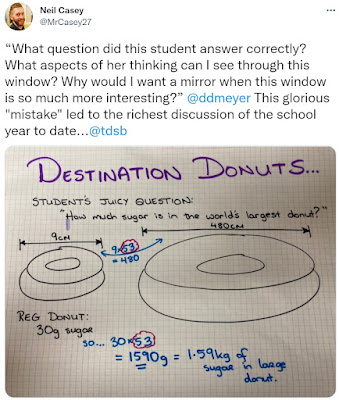Math is truth
I woke up this morning to this view...
I am in Vietnam right now visiting family, but it has also been
a perfect opportunity for me to inquire about math education here. I’ve been
curious because I have always seen a disconnect between the students from
Southeast Asia who have a very strong understanding of mathematics come from
what appears to be a very traditional, direct-instruction approach to teaching.
I had a chance to visit a high school, talk to the
administration, teachers, and students to find out more.
At first glance, the approach is indeed very traditional.
There are 45 students per class, sitting in rows of desks, taking notes from
the teacher who stands at a chalk board at the front. Students are asked to
show their understanding by coming to the front and explaining how they worked
through a problem.
However, when I talked to the students and teachers, I
noticed a few key differences from what I have seen in North America:
1. Conceptual understanding is valued and emphasized. As
students were working on questions individually, I heard a teacher say to the
class “stop when you understand the concept – don’t do questions that you
already understand.” Rather than focus on task completion, students are encouraged
to examine what makes each question different than the previous and to explain
their thinking to the class.
2. Professional development is integrated into everyday life
of a teacher. A part of a teachers schedule is to sit in and observe colleagues
while they teach. This can appear and feel like a constant evaluation, but when
I spoke to teachers, it was just a normal part of their learning. Feedback from
these observations is formative and constructive. What I liked the most was
that it created a sense of openness that welcomed people in to observe the
class.
3. Mathematics is seen as truth. This was an eye-opening
conversation that I had with a group of teachers of all subjects. They all
agreed that math is the most important subject – and there was no mention of it
being because it was practical. Math is seen as truth – aligned with fields
like philosophy and religion. There is no attempt to contrive applications of
mathematics when its beauty and power is in noticing and discovering how the universe works. The Pythagorean Theorem and Trigonometric ratios
don’t exist just so that we can figure out how tall a building is, they exist
as universal truths that can never be disproved. This perspective of
mathematics reminded me of the following ted talk that I just love: Math is forever.
Many students and adults I talk to in Canada believe that
mathematics is a man-made mechanism; that math would not exist without humans.
The formulas, notation, and systems we put in place are indeed man-made, but
they are all just ways for us to notice the universe around us. The concept of
a circle would exist whether we noticed it or not, and the relationship between
the circle's diameter and circumference would be a constant, irrational number
regardless if we had ever given it the name and symbol π.
I am not suggesting that math is not practical; some of the worlds most important developments were possible because of applied mathematics. However, I am
wondering if we are doing our students a disservice if we send a message that math was
invented by humans for only practical purposes; as a way to calculate tips for a bill, or to calculate the
interest on a mortgage. Perhaps we can get more kids passionate about math if
we help them see how powerful it really is.






Comments
Post a Comment